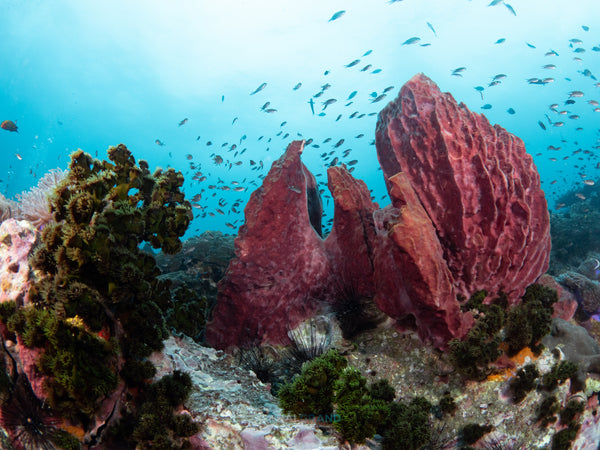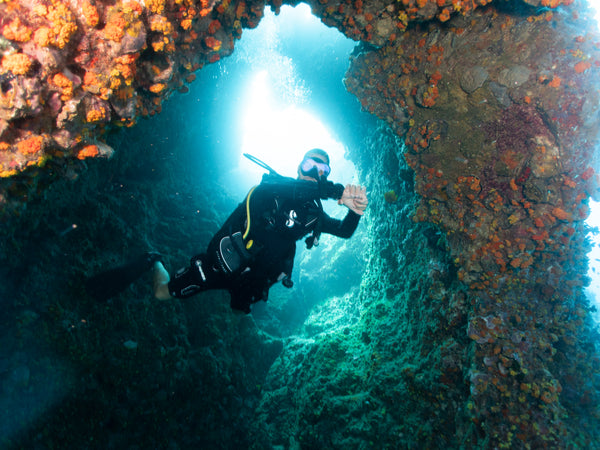Embarking on a journey to Koh Tao is often considered a once-in-a-lifetime experience, inviting travelers to savor the tropical delights of the island by engaging all the senses! However, beneath the waves, one sense—touch—holds potential harm to the marine ecosystem. Exploring and reaching out through touch is a fundamental human instinct, driven by our brain's inclination to gather information, especially in new environments like the ocean during a dive. Yet, it's crucial to resist this instinct when it comes to marine life. Our touch, no matter how well-intentioned, can cause significant harm to underwater ecosystems, making it imperative to refrain from it to preserve the health of our reefs!

Why Refraining from Touching Marine Life:
The Microbial Ecosystem of Our Skin:
Our skin hosts a diverse community of microorganisms, encompassing bacteria, viruses, and fungi. Engaging with marine life through touch is akin to intruding on their exclusive gathering with our own microbial entourage. The predicament lies in marine creatures lacking the robust immune system to fend off this microbial influx, making them susceptible to diseases they may struggle to combat and can lead to potentially severe consequences for their well-being.
Messing with Mucus:
Much like ourselves, every marine creature is enveloped in a protective layer of microorganisms called a mucus layer or slime coat. This layer serves as a dual-function shield, acting as a barrier against their immediate environment and harboring antimicrobial components for innate immunity. When we touch this delicate mucus layer, we strip it away and introduce our own colony of microorganisms. This disruption compromises their protective barrier, opening the door to potential diseases and life-threatening symptoms. Similarly, as our touch risks marine life by transferring our bacteria to them, their bacteria can threaten us.
Watch Out to Avoid Breaks:
Engaging with the underwater world entails a responsibility to minimize our impact, particularly when it comes to physical interactions. Delicate ecosystems, such as coral structures, take years to form, preserving a delicate balance and intricate symbiotic relationships crucial for survival. Corals, featuring a thin layer of tissue covering intricate limestone structures developed over their lifetimes, are highly vulnerable to damage. Any breakage or harm to this tissue can expose them to bacterial infections and diseases, posing a severe threat to the entire coral colony. Even the gentlest touch can break off these fragile corals, disrupting their growth and leaving them vulnerable to potential predators.
Oh, and here's a little heads up – certain coral types, like sea fans, have some chemicals on their surfaces that you'd want to steer clear of!

How can I ensure I don't accidentally touch or kick marine life?
- Before each dive, conduct a thorough buddy check to ensure nothing is dangling that could potentially damage the reef if dragged below you.
- Maintaining stability in the water while mastering buoyancy can be a challenge for new divers. To prevent accidental kicks, keep a distance between yourself and the reef, eliminating the temptation to grab onto something for stability.
- During a wall dive at spots like Sail Rock, stick to the blue side of your buddy as you get the hang of buoyancy. This approach ensures that even if you lose control, you won't accidentally bump into the amazing marine life around.
- Always be mindful of our movements; monitor your fins, limit arm movements, and embrace buoyancy control. It's not just a diving necessity; it's a way to respect and protect the delicate marine environment.
- Maintaining excellent buoyancy is the ultimate key to safeguarding marine life and habitats. It prevents the frantic kicking or sculling that could inadvertently harm delicate coral formations, all while ensuring your safety from potential hazards like sharp corals and venomous fish. Moreover, adept buoyancy control contributes to air conservation. By staying relaxed and using minimal energy, you not only protect the underwater environment but also extend your dive time without leaving you breathless. It's a win-win situation for you and the ocean!
If you find yourself yearning to enhance your buoyancy skills, opting for the Peak Performance Buoyancy Specialty course is a strategic move. This comprehensive program is designed to empower you with refined underwater control, elevating your diving proficiency.

Stay away from dodging Venom and Poison:
The captivating beauty of marine life often conceals the potent defense mechanisms employed by some species. Venoms, poisons, and toxins function as dual-purpose tools, acting as protective shields and efficient hunting mechanisms. This poses a substantial risk to humans, highlighting yet another reason why we should refrain from touching marine life.
Venom VS Poison:
Venom is injected, while poison is ingested. Venomous ocean animals generate specific toxic substances that can be injected into their adversaries, typically through bites or stings. In contrast, poisonous animals coat part or all of their bodies with a toxic substance, making them harmful to consume or touch.
HANDS OFF!
Venom:
The lionfish, adorned with neurotoxin-laden spines, deploys these as a formidable defense. Punctures from these spines can unleash venom, causing intense pain, respiratory distress, and even paralysis in humans.
The Banded Sea Krait relies on its potent venom to paralyze prey before consuming it whole. Despite possessing ten times more lethal venom than a cobra or rattlesnake, their generally docile nature results in relatively infrequent bites to humans.
The Scorpionfish boast spines armed with potent venom. Upon piercing a predator, the venom is swiftly injected at the site of contact. For other animals, a sting from these spines can be life-threatening, while for humans, it inflicts intense pain. The scorpionfish's perilous nature is amplified by its exceptional camouflage, deceiving unsuspecting observers who may mistake it for a harmless rock.
Poison:
The pufferfish, a curious and intriguing creature, harbors a potent secret within its petite frame. Possessing enough poison to kill 30 adult humans potentially, these unique fish deploy a defense mechanism that makes them not only bad-tasting but often deadly to other fish. At the heart of their toxicity lies tetrodotoxin, a substance up to 1,200 times more lethal than cyanide, rendering encounters with these fish a risky affair!
The boxfish is closely related to the pufferfish, although it doesn't wield the same level of toxicity. The boxfish utilizes its poison to defend itself against predators, ensuring it remains off the menu for potential threats. In a fascinating display of self-preservation, the boxfish excretes toxins into the surrounding water, creating a poisonous shield that deters predators and safeguards its existence in the intricate dance of marine life.
Nudibranchs have a fascinating survival strategy. They absorb and store toxins from their food, making them toxic to predators that eat them! Scientists are still figuring out how they manage to thrive despite ingesting so many toxins!
Is It Ever Okay to Touch Marine Life?
So, the burning question: is there ever a situation where touching marine life is acceptable? Well, in about 99% of cases, the resounding answer is NO – but there are exceptions based on the context.
- Participating in a 'Dive Against Debris' initiative may involve relocating marine creatures before cleaning up ocean debris.
- Engagement in a coral restoration program may require careful interaction with corals for cleaning or implanting onto the reef to promote growth.
- In the face of a challenging strong current, holding onto the reef may be necessary to prevent getting swept away. In these instances, strive to grasp a bare rock using only your index finger and thumb, ensuring your safety and minimizing impact on the reef, or consider using a reef hook when it's a viable option.

Take nothing but memories, leave nothing but bubbles:
We get that irresistible urge to reach out and touch the passing turtle, whaleshark, or that fascinating shell. But it's essential to realize the potential impact of this seemingly innocent action. Not only does it pose a risk of causing harm to marine life, but it also threatens their habitat, messes with ecosystems, and interferes with their natural behavior. It's not just about the risk of causing harm to marine life; it's a whole deal that threatens their homes, ecosystems, and even their daily routine. Plus, let's remember it could put a damper on our own health and safety. As responsible divers, we need to exercise self-control and resist our human impulses.
Being mindful of our actions is a personal commitment and an opportunity to set an example for others. Let's avoid following or endorsing irresponsible behaviors often seen on social media. By keeping our hands to ourselves, we contribute to the well-being of the ocean and its inhabitants!
Contact us to book your scuba diving package and embark on an adventure that respects and preserves the underwater world. Leave only photos, take only memories, leave nothing but bubbles, and keep Koh Tao and its inhabitants happy and healthy!

